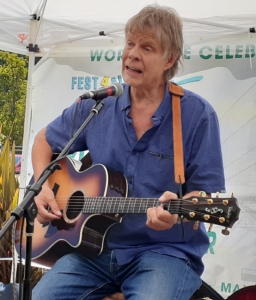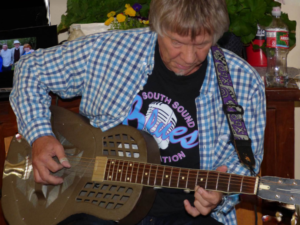| Article by Kevin Cummings, SSBA VP / Editor
Ross Robinson is a gifted guitarist who is dedicated to keeping a special style of acoustic blues alive and humming. Country Blues is a particular style of music that has nothing to do with Country and Western music. It is Piedmont Blues or Delta Blues music that was made popular by people like Mississippi John Hurt, Robert Johnson, Gary Davis and Tampa Red. It is from the 1920s and 30s.
Robinson, a terrific wealth of history and experience in this style, is an ambassador for the style, and if you are lucky enough to catch on of his shows or listen to his stories, you will feel better for it.
Growing up in Rhode Island, just a few miles from where the Newport Jazz and Folk festivals were held. You might have thought that those styles would have resonated with him, but they didn’t grab his soul. He had no siblings to guide him regarding music, and his parents were too busy running their business to focus on the music scene.
His parents had some musical talent, but it was always on the back burner. His dad played four-string instruments like the ukulele, tenor guitar and tenor banjo. As a young child, his father was taught a few chords by a troupe of traveling minstrels, he became proficient, but set it aside to support the family; he only played at Christmas and special occasions. Robinson’s mother played piano and could sing harmony. Ross’ parents “were depression era people who didn’t do much past Bing Crosby, the Andrews Sisters and church music. They never got the folk music explosion; when Time magazine and Newsweek both ran a cover of Bob Dylan in the same month, my old man asked who he was”.
A neighbor girl turned him onto the Beatles at about age 5, then he found FM radio at about thirteen. He liked listening to the Beatles, Led Zeppelin, and Bob Dylan among others, but he was really into Doc Watson, David Bromberg and Jorma Kaukonen from Jefferson Airplane.
Going to Chicago for college really opened him up to the blues scene. At about 20, he got his first guitar – a “Japanese or Chinese thing where the action was about half an inch above the neck and cost $35”. At around this same time he was a disc jockey at a community radio station in the area, it allowed him to meet and interview many legends such as Pete Seeger, Jerry Garcia, David Bromberg and Bob Dylan. Ross shared that he med Bob Dylan at a Grateful Dead concert; “He was saying hello to some people who were in wheelchairs with disabilities. I was standing there and touched him on the arm, he was smoking a parliament cigarette and drinking a glass of white wine”.
As a youth, he was a drummer in the high school band. When he picked up the guitar, he was fascinated with learning the instrument at a high level. He spent the early years flat-picking and then began focusing on right hand techniques, finger-picking and open tunings. His first forays into performing were as a busker in the Chicago Subway system. His college friends were working on their careers and making about seven dollars an hour, he was getting about five per hour as a busker and that suited him just fine. His first paying gigs were playing at a nursing home in the area, with a friend who was a magician and guitar player.
“I was kind of slow the beginning, it took about five years before I could actually play lead guitar”. After a few years he upgraded to a Takamine Concert Body Acoustic, then he got an Guild D-25 the American made guitar that he wanted.
By 1986 he was in Boston and started doing a few shows with a buddy in a five piece band, and was playing lead guitar for a singer-songwriter who had a four piece band that played the Tuesday / Wednesday night gigs at rock clubs. He knew what a promo kit was – a bio, a picture and a cassette tape with 3 songs on it; “in those days if you had a promo kit you could get $50 gigs at local places”. His first big gig was at Tufts university in 1989, they offered him $150.00 which was “a lot of money to me at the time”. Then he made the decision to focus on fingerstyle guitar and the Country and Delta Blues genre. Even to this day, he practices the guitar two or three hours a day, six days a week.
The rest is history. Robinson shares his talents here in the Pacific Northwest, playing solo or sometimes with a bassist as accompaniment. He says he likes to connect with the audience and play from his extensive repertoire, based on what he feels they want to hear. When he plays with another person, he pares his catalog down to about 25 songs so that he doesn’t overwhelm them.
When considering advice for new musicians, or people considering getting into the music industry, Ross’ advice is “don’t give up your day job until your night job is paying the bills”. He further emphasizes that it is critical for people work hard on honing their skill and find a good open mic – “they are a great way to learn how to connect with the listeners”.
When asked how he thinks performance has changed over the years, he focused on how the old-timers never used electronics, “now people want capo’s and pickups, the original guys didn’t use any of that stuff – and they all sat down when they played”.
To learn a bit more about Ross Robinson, check out the links below.
Washington Blues Society Blues Bash from last September, when Ross opened for Joel Astley. The show begins at around the twenty minute mark – just fast forward through the black screen and enjoy.
For more of the wonderful and historic Country Blues of Robinson’s style:
Do yourself a favor and get out to one of his shows, you’ll be glad you did. While you’re at it, ask him a question about Peter Wolf, or Steve Cropper, or Jorma Kaukanen, or Mississippi John Hurt, or anything to do with Country and Delta Blues – prepare to be impressed. |



